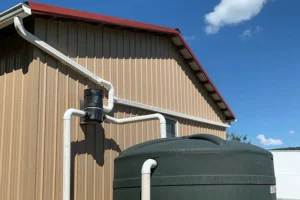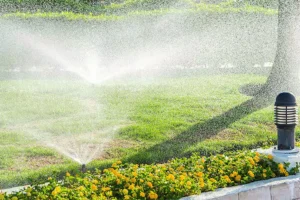If you live in Austin, TX, you know we get our fair share of big rain events… and dry spells. That’s why more and more homeowners are turning to a rainwater harvesting system for home use.
These systems take the rainfall from your roof and turn it into a water supply you can actually use. From lowering your water bill to having cleaner water for your plants, a rainwater harvesting system is a smart move in Central Texas.
Let’s talk about how these systems work, the parts involved, and why it’s not just for folks out in the Hill Country anymore.
What Is a Rainwater Collection System?
A rainwater collection system is a setup that catches rain from a catchment area (usually your roof), sends it through a gutter system, filters it, and stores it in a tank or cistern.
The harvested rainwater can then be used for irrigation, potable water (with proper filtration), or non-potable uses like washing vehicles and flushing toilets.
In Austin, many residents are upgrading from a simple rain barrel to a larger, more efficient system.
How Does Rainwater Harvesting Work?
Step 1: Catching Rainfall
Catchment area: Usually your roof. The bigger the roof, the more rainwater you can collect.
Gutter system: Directs rainwater from your roof into a downspout connected to the collection system.
Step 2: Filtering and First Flush
First flush diverter: Sends the first few gallons of rainwater away to remove dust, pollen, and roof debris.
Basic filters: Remove leaves, twigs, and larger particles before water reaches the tank.
Step 3: Storage in the Tank or Cistern
Tank or cistern: Can be above ground or below ground. Sizes range from small (500 gallons) to large (2,500 gallons or more).
Material choice: Tanks can be made of plastic, galvanized steel, or concrete, depending on budget and style preference.
Step 4: Distribution for Use
Gravity feed or pump: Moves stored water to where you need it.
Distribution systems: Connect to irrigation systems, drip lines, or even indoor plumbing for potable water use.
Why Should Austin Homeowners Think About Rainwater Collection?
In Austin, every drop counts. Rainwater collection turns those sudden downpours into a steady water supply, helping homeowners save money and use water wisely.
- Water conservation: Rainwater harvesting helps reduce demand on municipal water.
2. Lower water bills: Using harvested rainwater means you rely less on city water.
3. Better water quality for plants: Rainwater is naturally soft and free from chlorine.
4. Emergency water supply: A full tank can be a helpful backup during water outages.
5. Stormwater management: Helps control runoff and flooding during heavy rainfall.
What Does a Residential Rainwater Collection System Include?
Here are the main parts of a residential rainwater collection system, all working together to catch, store, and deliver rainwater where you need it.
Catchment surface
Usually, your roof. Metal roofs are especially good because they shed water quickly and cleanly.
Gutters and downspouts
Direct water into the collection system. Keeping these clean is important for good water quality.
First flush device
Keeps the initial, dirtier rainwater out of your storage.
Pre-filtration system
Screens out leaves, grit, and insects.
Storage tank or cistern
Holds the collected rainwater until you need it.
Pump system
Sends water from the tank to where you’ll use it, such as irrigation systems or household fixtures.
Filtration for potable use
Adds extra treatment steps like carbon filters or UV light if you plan to drink the water.
Distribution system
Gets the water where it needs to go — lawn, plants, or indoor uses.
Can I Use Harvested Rainwater for Drinking?
Yes — but only if you have a potable water system installed. That means your rainwater harvesting system will include extra filtration and disinfection steps, like UV light treatment and fine particle filters. Many homeowners around Austin also choose to keep their rainwater for non-potable uses, which doesn’t require as much treatment.
How Much Rainwater Can I Collect in Austin?
Austin averages around 34 inches of rainfall each year. The amount you can harvest depends on your roof size:
A 1,000 sq ft roof can collect over 20,000 gallons of rainwater a year.
A 2,000 sq ft roof can collect over 40,000 gallons.
Even if you don’t have a huge roof, you can still gather plenty of water for irrigation and other outdoor uses.
Is Rainwater Harvesting Worth It in Central Texas?
Absolutely. With the City of Austin offering rebate programs for certain rainwater harvesting systems, you can cut down on installation costs. Plus, the savings on your water bill add up over time. For folks in the Texas Hill Country, it can even replace or supplement a well water supply.
How Long Does a Rainwater System Installation Take?
For smaller setups like upgrading from a rain barrel, it can be done in a day or two. Larger, more complex systems with bigger cisterns, pumps, and filtration might take a week or more. Austex Sprinklers can design and install systems that fit your home’s water needs and your property’s layout.
What Are Some Common System Designs Around Austin?
Above-Ground Tank Systems
Good for easy maintenance and lower cost. Tanks can be hidden with landscaping or fencing.
Below-Ground Cistern Systems
Great for saving space and keeping water cool, which helps with water quality.
Hybrid Systems
Mix of above-ground and underground storage, perfect for larger properties or homes with multiple water uses.
What’s the Difference Between Potable and Non-Potable Rainwater Systems?
Potable systems: Rainwater is filtered and disinfected so it’s safe for drinking, cooking, and bathing.
Non-potable systems: Water is stored for outdoor irrigation, washing vehicles, or other uses where drinking quality isn’t needed.
I recently considered installing a rainwater harvesting system at my home in Austin, TX, especially since I have a large lawn that requires regular irrigation. However, I wasn’t sure whether to choose a potable or non-potable system. After consulting with the team at Austex Sprinklers, I learned that the difference comes down to how the water is treated and the intended use. A potable system is designed to filter and disinfect the rainwater, making it safe for drinking, cooking, and bathing. This seemed like a great option for my family, but I also realized that it requires more advanced filtration and higher initial costs. On the other hand, a non-potable system is much simpler, storing rainwater for outdoor irrigation, washing vehicles, or other uses where drinking-quality water isn’t necessary.
Considering my needs, the team at Austex Sprinklers recommended a non-potable system since I only needed the water for landscaping and outdoor purposes. They helped me design a system that fit my lawn care needs and also helped me take advantage of local rebates for water conservation. The entire process was smooth, and now I can keep my lawn green while saving on my water bill. I’m really happy with the results and appreciate how the team at Austex Sprinklers made the whole decision easy to navigate. – Sarah Wilson, Greenbelt Drive, Austin, TX.
Maintaining Your Rainwater Catchment System
Below are simple steps for maintaining your rainwater catchment system so it keeps working smoothly and gives you clean, usable rainwater.
- Keep gutters clean: Prevents leaves and debris from entering the system.
- Check filters regularly: Dirty filters slow down water flow.
- Inspect the tank: Make sure there are no cracks or leaks.
- Service pumps: A working pump means steady water pressure.
Conclusion
Rainwater collection systems aren’t just for farms out in the Texas Hill Country — they’re a smart choice for Austin homeowners who want a reliable water supply, better water quality for plants, and a lower water bill. If you’re collecting rainwater for irrigation systems, potable use, or just as a backup source of water, a well-designed rainwater harvesting system can make a big difference.
If you’re ready to explore rainwater harvesting solutions, call Austex Sprinklers. They can design and install a customized rainwater collection system that works for your home, meets City of Austin rebate requirements, and helps you conserve water year-round.
Understanding the cost and benefits of rainwater collection systems is key to making an informed decision, and Austex Sprinklers can guide you through both the financial and environmental advantages of setting up your system.
Contact Austex Sprinklers today at (512) 721-8564 to get started on your rainwater collection project!
Frequently Asked Questions
1. Do I need a permit to install a rainwater system in Austin?
Most residential rainwater collection systems do not require a permit if they’re for outdoor use. If you plan to connect it to indoor plumbing for potable water, the City of Austin has specific requirements.
2. How often should I clean my rainwater tank?
Most tanks only need a light cleaning every 2–3 years if you have good filtration. Regular gutter cleaning helps reduce the need for tank cleaning.
3. Can I still collect rainwater if I have asphalt shingles?
Yes. While metal roofs are the most efficient for collecting rainwater, systems can be designed for asphalt shingles, too, with the right filters and first flush systems.




